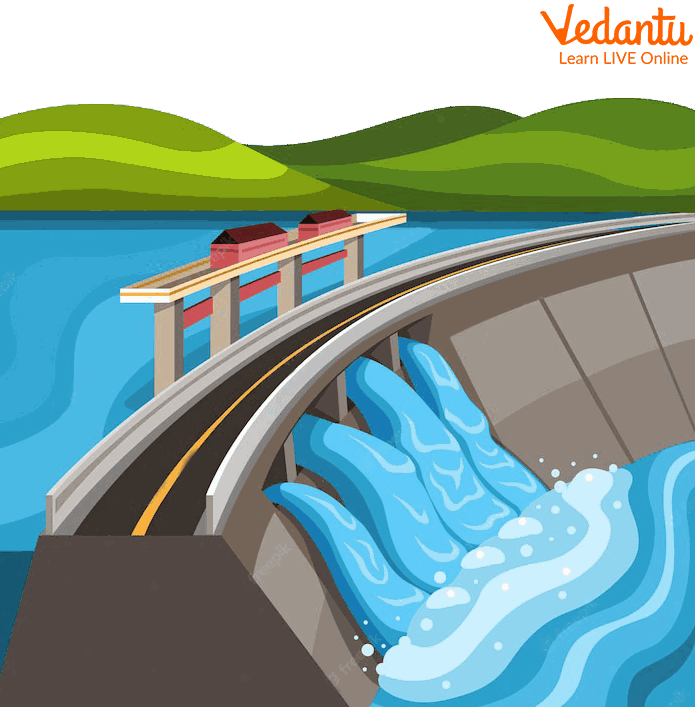




What is a Flood?
A flood is generally defined as the overflow of large amounts of water on the earth's surface, causing destruction. Floods can occur due to many reasons like as a result of strong rains, incoming waves from the ocean, or the failure of dams or levees. Floods can happen suddenly or gradually over a long period and can last up to many days or weeks or even longer, depending upon the type and extent of the flood. Out of all the natural disasters, floods are the most common, seen all over the country at certain times.

The Flood Prevailed Everywhere in the Village and Drowned Everything.
What is Flooding?
Understanding floods is crucial when talking about them. So, we'll first try to understand the basic definition of flood.
A flood is when there is an excessive amount of water, and it usually covers dry areas. The science of hydrology includes studying floods. They may also start slowly and then pick up speed.
Causes of Flood
Flooding has a wide range of diverse causes. While different flood types often have various reasons, one of the following actions is responsible for most floods.
Heavy Rainfall- A lot of rain is the most specific cause of flooding. Sometimes, the water that falls on the earth's surface by rain doesn't get a proper place to be stabilised. This may cause flooding, including turbulent flash flooding.
Overflowing- The overflowing of many water bodies like big rivers and lakes can cause floods.
Damaged Dams Can Also Cause Broken Dams-Flooding. When there is a lot of rain, it's obvious that the water level will rise, resulting in older infrastructure collapsing. The aftermath of Hurricane Katrina's 2005 landfall in New Orleans included this.
Melting Snow and Ice- Another typical cause of floods is melting snow and ice. If a lot of snow melts quickly, it frequently has nowhere else to go but low-lying places.
What are the Effects of Flood?
Floods have a negative social, economic, and environmental impact on both persons and communities. Depending on the location and intensity of flooding, as well as the susceptibility and value of the natural and built environments they touch, the Effects Of Floods—both positive and negative—vary dramatically.
Floods can have various effects, including good and bad, depending on where they occur, how quickly they move, how vulnerable they impact nature and built infrastructure, and so on. Floods have adverse social, economic, and environmental effects on individuals and communities.
Methods of Flood Management
Some flood control techniques date back to ancient times. These techniques include building floodways, terracing hillsides to restrict flow downstream, and planting vegetation to hold surplus water (artificial channels to divert flood water).
Levees, lakes, dams, reservoirs, and retention ponds are other methods for storing extra water during floods. Some other techniques to manage floods are
Construction of Dams- Many dams and the reservoirs they are connected to have flood control and protection as one of their primary goals. In order to provide a specific amount of room for flood waters to fill, many large dams include flood-control reservations where the level of a reservoir must be kept below a particular elevation before the start of the rainy/summer melt season.
River Defences- Rivers are frequently carefully controlled because they are prone to flooding in many nations. Levees, reservoirs, and weirs are utilised as defences to stop rivers from overflowing their banks and prevent flooding.
Floodplains and Groundwater Replenishment- By redirecting extra water onto terrain that can soak it up, groundwater can be refilled. Through the use of the ground as a natural reservoir, this method can lessen the effects of future droughts.

A Dam Into Which Water Flow is Open at Full Speed.
Interesting Facts About Floods
Floods have occurred at some point in the history of mankind in most cultures and civilisations.
For practical reasons, ancient civilisations erected their monarchies next to rivers. River floods that harmed their lands and kingdoms were a problem they had to contend with over time.
Since ancient times, dams and levees have served as a flood defence system.
During the dry seasons, flood water is occasionally gathered for irrigation to irrigate crops.
Cities may be washed away by powerful floods that breach dams. They have the power to demolish bridges, highways, and other structures, uproot trees and bring about hurricanes.
Conclusion
Floods might be frightening, but it is up to us as individuals to ensure they don't interfere with our daily lives. Ponds, lakes, and other water reservoirs should all be kept in good condition. Flooding can be prevented by enhancing the soil's properties and making it easier for water to absorb.
FAQs on Flood - A Natural Disaster
1. What is a flood and what happens during one?
A flood is a natural disaster that happens when a large amount of water overflows and covers land that is usually dry. During a flood, water levels in rivers, lakes, or oceans can rise quickly, spreading into nearby towns and villages. This can cause significant damage to homes, farms, and roads.
2. What are the main causes of floods?
Floods are mainly caused by a few key factors. These include:
- Heavy Rainfall: When there is too much rain in a short period, rivers and drainage systems cannot handle the excess water.
- Overflowing Rivers: Continuous rain or rapid snowmelt can cause rivers to rise above their banks.
- Dam Breaks: An old or poorly maintained dam can break, releasing a huge volume of water suddenly.
- Coastal Storms: Strong winds and high tides, especially during a cyclone, can push seawater onto the land.
3. Are there different types of floods?
Yes, floods can happen in different ways and are often categorised by their cause and duration. The main types include:
- Flash Floods: These occur very suddenly with little warning, usually due to intense rainfall over a small area.
- River Floods: These happen more gradually when a river or stream overflows its banks.
- Coastal Floods: These are caused by high tides, tsunamis, or storm surges from the sea pushing water inland.
4. What are the major effects of a flood on people and the environment?
Floods have serious negative effects. For people, they can destroy homes, damage crops, and contaminate drinking water, which can lead to the spread of diseases like cholera and typhoid. Environmentally, floods can erode soil, destroy natural habitats for animals, and pollute water bodies with debris and chemicals.
5. Are floods always natural, or can human activities cause them?
While most floods are natural disasters, certain human activities can significantly increase their frequency and severity. For example, deforestation (cutting down trees) reduces the soil's ability to absorb water. Unplanned construction in flood-prone areas, known as floodplains, and the failure of man-made structures like dams are also major contributors to flooding.
6. How does planting more trees help in managing floods?
Planting trees, known as afforestation, is a very effective natural method for flood management. The roots of trees bind the soil, preventing it from being washed away. More importantly, the soil in a forest acts like a giant sponge, absorbing large amounts of rainwater and releasing it slowly. This reduces the amount of water that runs off quickly into rivers, thus lowering the risk of them overflowing.
7. What is flood management and why is it important?
Flood management refers to the various methods and strategies used to reduce the harmful impacts of floods. It is crucial for protecting lives, property, and infrastructure. Key methods include constructing physical barriers like dams and levees (walls along rivers), establishing early warning systems, and educating communities about safety measures and evacuation plans.
8. Besides causing damage, can a flood ever be beneficial?
While floods are overwhelmingly destructive to human settlements, they can have some positive ecological effects in natural floodplains. Floodwaters carry and deposit rich, fertile soil called silt across the land. This natural process makes the soil highly productive for agriculture once the water recedes. Floods also play a role in recharging groundwater reserves.
9. What are some simple safety measures to take before and during a flood?
To stay safe, it is important to be prepared. Before a potential flood, you should secure your belongings on higher ground and prepare an emergency kit. During a flood, it is critical to move to the highest ground possible. You must never walk or drive through floodwaters, as even a few inches of moving water can be strong enough to sweep you away.









